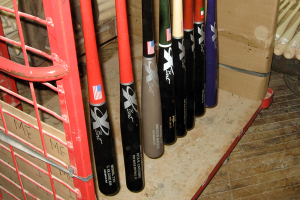Our softball bats come in 10 different models. Per ASA rules, all softball bats are identical from the transition through the 2 1/4" barrel. The differences are in the handle thicknesses and knob styles.
Our Model ASA 59 and Softball 59 both have thin 7/8" handles and would be good ones to consider. The ASA Spec model has a straight handle all the way to the knob. The Softball 59 handle tapers to the knob.
Our Model ASA 41 and Softball 41 both have 15/16" medium handles and would be good ones to consider. The ASA Spec model has a straight handle all the way to the knob. The Softball 41 handle tapers to the knob.
Our Model ASA 61 and Softball 61 both have 1" thick handles and would be good ones to consider. The ASA Spec model has a straight handle all the way to the knob. The Softball 61 handle tapers to the knob.
Our Model ASA 71 and Softball 71 both have 15/16" medium handles with a flare to the knob. The ASA 73 and Softball 73 both have 15/16" medium handles with large knobs to counter balance the weight in the barrel for a lighter swing feel. If you are looking for a flared handled bat, these would be good ones to consider. The 73 is our most popular model because of the balance and comfort of the handles.
There have been lots of questions from players switching from aluminum to wood softball bats as to what weight to order. Most try to get a –5 since they think the bat speed is important. They are accustomed to swinging the lightest aluminum bat possible since weight and mass behind the ball does not matter with aluminum bat barrels which provide all the pop by virtue of the material used and the thin walls. With wood softball bats, especially for slow pitch, it is important to have as much mass behind the ball as possible. The heavier the bat you can swing, the further and faster the ball will travel. A bat at an even weight differential will hit a ball harder and further than a wood softball bat with a –5 weight differential (the weight in ounces is calculated by taking the length of the bat in inches less or plus the weight differential, so a 34 inch bat with a –5 weight differential would weigh 34-5=29 ounces). Slow pitch players have plenty of time to start their swing so needing a light bat to enable the player to wait as long as possible to avoid getting fooled by the pitch is not an issue as it is in baseball.
The heavier the wood bat you swing in softball, the harder and further the ball will travel. With slow pitch softball, it is purely about the mass behind the ball. Simple physics. You can certainly swing a broomstick faster than a –5 but how far would the ball go. Baseball players try to use a lighter (actually a bat that feels lighter which means it is more balanced as the weight of the bat is not a reliable indicator of how it “feels”)so they can wait and wait and wait to the last fraction of a second to swing at a pitch. The longer they are able to wait, the less chance they have of being fooled by the pitcher. In slow pitch softball, players have “all the time in the world” compared to baseball so the weight is not important. The heaviest wood softball bat you can swing is what you want to hit the ball harder and further.
Most power hitters like a bat that is from even to +5 and most guys that like a lighter bat go with even to -2.
